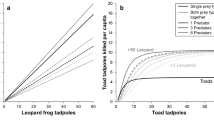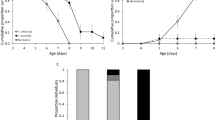Summary
A key assumption of conventional opitmal diet theory is that foragers cannot search for prey while already handling one prey item. Some foragers, however, can handle multiple-prey loads; i.e., they can search for, attack and handle further prey when already handling one or more prey. We examined diet selection by small-mouthed salamander larvae, Ambystoma texanum, that can search while handling up to two prey at a time. We gave A. texanum larvae a choice between two size classes of Daphnia pulex at two prey densities. Larval A. texanum diet choice did not fit the predictions of conventional optimal diet theory, but fit very well with the predictions of a multiple-prey model. At low prey density, A. texanum larvae were nonselective. At high prey density, larvae were non-selective when their mouths were empty, but showed a strong preference for larger, more valuable prey when larvae already had prey in their mouths. In 16 out of 18 instances, foragers either accepted or rejected small prey in keeping with a multiple-prey model's predictions.
Similar content being viewed by others
References
Burns CW (1969) Relation between filtering rate, temperature and body size in four species of Daphnia. Limnol Oceanogr 14:693–700
Chesson J (1983) The estimation and analysis of preference and its relationship to foraging models. Ecology 64:1297–1304
Connell JH (1978) Diversity in tropical rain forests and coral reefs. Science 199:1302–1310
Juliano SA (1987) Simple queueing models for predation: consequences for foraging theory. Bull Ecol Soc Am 68:334
Lucas JR and Grafen A (1985) Partial prey consumption by ambush predators. J Theor Biol 113:455–473
McNair JN (1983) A class of patch use strategies. Am Zool 23:303–313
Paine RT (1966) Food web complexity and species diversity. Am Nat 100:65–75
Petranka JW (1984) Sources of interpopulational variation in growth responses of larval salamanders. Ecology 65:1857–1865
Petranka JW, Sih A (1986) Environmental instability, competition and density-dependent growth and survivorship of a stream-dwelling salamander. Ecology 67:729–736
Petranka JW, Sih A (1987) Habitat duration, length of the larval period and the evolution of a complex life cycle of an amphibian. Evolution 41:1347–1356
Sih A (1982) Optimal patch use: variations in selection pressure for efficient foraging. Am Nat 120:666–685
Sih A, Crowley P, McPeek M, Petranka J, Strohmeier K (1985) Predation, competition and prey communities: a review of field experiments. Ann Rev Ecol Syst 16:269–311
Smith CK, Petranka JW (1987) Prey size-distributions and size-specific foraging success of Ambystoma larvae. Oecologia 71:239–244
Stephens DW and Krebs JR (1986) Foraging theory. Princeton University Press, Princeton
Wiens JA (1977) On competition and variable environments. Am Sci 65:590–597
Winterhalder B (1983) Opportunity cost foraging models for stationary and mobile predators. Am Nat 122:73–84
Zaret TM (1980) Predation and freshwater communities. Yale University Press, New Haven
Author information
Authors and Affiliations
Rights and permissions
About this article
Cite this article
Sih, A., Petranka, J.W. Optimal diets: simultaneous search and handling of multiple-prey loads by salamander larvae. Behav Ecol Sociobiol 23, 335–339 (1988). https://doi.org/10.1007/BF00300580
Received:
Accepted:
Issue Date:
DOI: https://doi.org/10.1007/BF00300580




